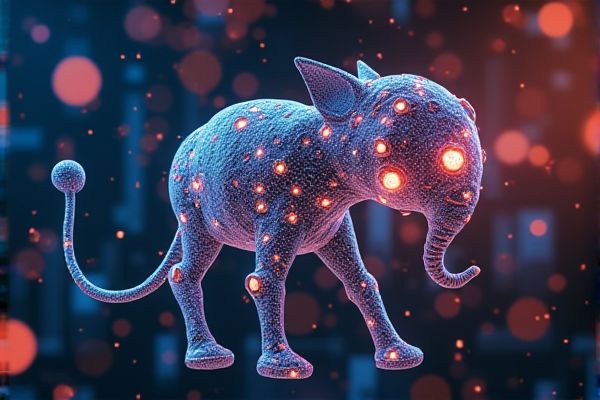
AI technologies are transforming visual arts and design by providing innovative tools that enhance creativity and efficiency. Artists utilize AI algorithms to generate unique artworks, automate repetitive tasks, and explore new styles, fostering a collaborative relationship between human creativity and machine intelligence. Designers benefit from AI-driven insights that analyze market trends and consumer preferences, enabling them to make informed decisions and create more resonant visual content. The integration of AI not only expands the possibilities of artistic expression but also democratizes the creative process, allowing individuals without formal training to engage in art and design with accessible tools.
AI usage in visual arts design
Generative Art Creation
AI tools in visual arts design, particularly in generative art creation, offer artists the chance to explore novel aesthetics and concepts. Programs like DALL-E allow creators to generate unique artworks based on textual prompts, expanding the boundaries of traditional art forms. This technology increases accessibility for non-artists to engage in creative processes, potentially democratizing artistic expression. The incorporation of AI can lead to collaborative works that blend human creativity and algorithmic innovation, suggesting new avenues for artistic exploration.
Style Transfer Algorithms
Style transfer algorithms can enhance the creative process in visual arts design by allowing artists to apply the stylistic elements of one image onto another. These algorithms analyze the content and style of reference artworks, enabling the generation of unique compositions. A notable example is the use of neural networks to recreate the aesthetics of renowned artists like Vincent van Gogh in new digital pieces. This technology presents an opportunity for designers to explore innovative styles and expand their artistic repertoire.
Image Recognition and Analysis
AI has the potential to significantly enhance visual arts design by automating repetitive tasks and providing creative suggestions. Image recognition technology can analyze existing artworks, offering insights into styles and trends that may inspire artists. Tools like Adobe Sensei utilize AI for smart editing features, allowing designers to focus more on creativity. This integration of AI can lead to innovative artistic expressions and more efficient workflows in institutions like art schools.
AI-driven Animation
AI usage in visual arts design presents opportunities for enhanced creativity and efficiency. Tools like DALL-E can assist artists in generating unique imagery based on text prompts, potentially expanding their artistic repertoire. In AI-driven animation, software such as Runway ML enables quicker production timelines while allowing for intricate styles. This integration of AI could lead to new artistic movements that blend human creativity with machine-generated elements.
Virtual Reality Art Spaces
AI can enhance visual arts design by generating unique artwork and optimizing design elements. In virtual reality art spaces, AI can create immersive experiences that adapt to user preferences. For instance, artists at institutions like the Rhode Island School of Design are exploring AI's potential in collaborative projects. The possibility of combining human creativity with AI capabilities opens new avenues for artistic expression and innovation.
Interactive Installations
AI can enhance visual arts design by generating unique artwork based on predefined themes or styles. For instance, artists might leverage tools like DeepArt or Adobe's AI features to create interactive installations that engage viewers in novel ways. The probability of increased audience engagement is high when AI is utilized to personalize experiences based on individual preferences. This potential for customization may lead to more dynamic and memorable art interactions, benefiting institutions like museums or galleries.
Real-time Rendering
AI can enhance visual arts design by automating routine tasks, allowing artists to focus on creativity. Real-time rendering technologies can improve the efficiency of visual presentations, enabling quicker iteration and feedback. This integration of AI tools may lead to new design opportunities in industries such as gaming and film. Designers using AI for real-time rendering may experience a significant advantage in delivering high-quality visuals within tight deadlines.
AI in Augmented Reality Art
AI can enhance visual arts design by automating certain creative processes, allowing artists to explore new styles and concepts more efficiently. In augmented reality art, AI can generate interactive elements that respond to audience movements, creating a more immersive experience. For instance, the integration of AI in tools like Adobe Creative Suite can streamline workflows and provide innovative creative solutions. This collaboration between technology and art opens up possibilities for unique artistic expressions and broader audience engagement.
Artistic Collaboration Tools
AI usage in visual arts design offers the possibility of enhancing creativity through innovative tools such as Daz 3D. Artists can leverage automated features to streamline their workflows, allowing them to focus more on the creative aspects of their projects. Collaboration tools incorporating AI may provide real-time feedback, improving the elements of design and composition. This integration could open new avenues for artists, ultimately broadening their reach and impact in the visual arts community.
Data-driven Aesthetic Enhancement
AI tools can analyze vast datasets of visual elements to identify patterns and trends that resonate with audiences. For instance, designers at institutions like the Rhode Island School of Design can leverage AI for data-driven aesthetic enhancement. This technology allows for more personalized and engaging artwork by predicting user preferences and tailoring designs accordingly. The potential for increased creativity and targeted outcomes can give artists a competitive edge in the evolving market.
 techknowy.com
techknowy.com